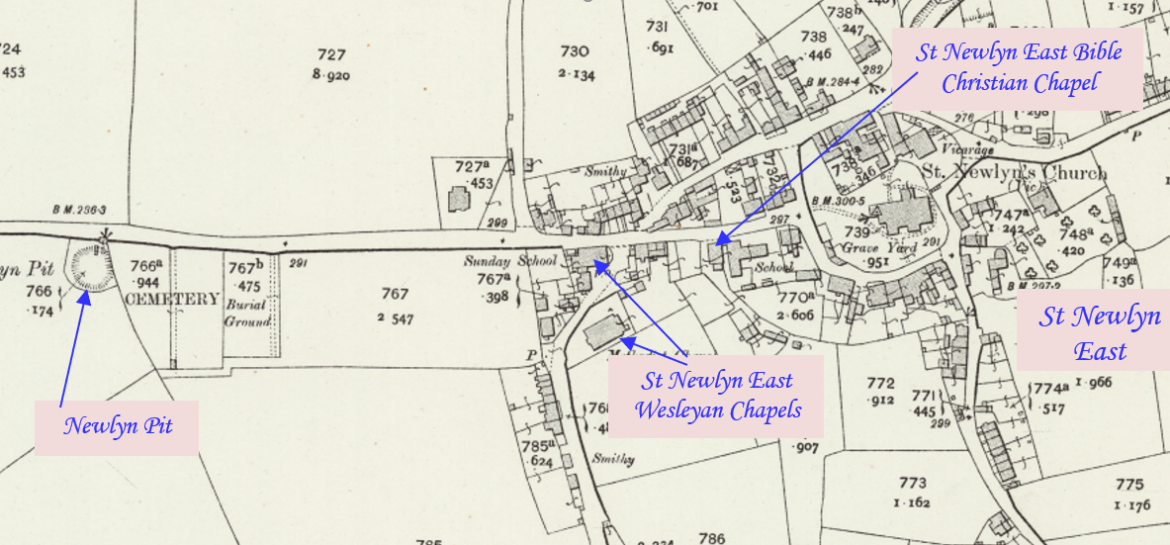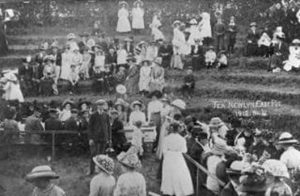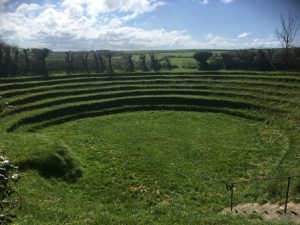
St Newlyn East is a village approximately three miles (5 km) south of Newquay. The name St Newlyn East is locally abbreviated to Newlyn East and according to an anonymous historian writing in The Cornishman in 1880 it was only in recent years that Saint had been added to the parish name. This profile of St Newlyn East Preaching Pit has been compiled by Jo Lewis and Tony Mansell.
The preaching pit can be found by travelling east out of the village, on Cargoll Road, next to the cemetery.
1840s: The stone quarry (the Pit), had fallen into disuse.
Possibly used for wrestling and cockfighting.
1848: One stormy Sunday, lay preacher John Andrew led his congregation out of the chapel and to the shelter of the old quarry.
1846: After the East Wheal Rose pit disaster the pit was graded into tiers and dedicated to the memory of those who died in the disaster.
Preaching pit with tea hut. Built as a memorial to the 36 men who died in the East Wheal Rose Lead Mine disaster. Earth step amphitheatre with rostrum plat. Tea room is a small stone rubble building with a scantle slate roof (extant at time of inspection but since vandalised and to be reinstated). One of 4 landscaped preaching pits in Cornwall. (Cornwall Council Gateway Heritage) (It was actually 39 men and boys – Barry West)
In the 19th century Newlyn East was a thriving mining community whose history was marred by a disaster in 1846 at the East Wheal Rose mine. An unusually heavy thunderstorm on 9th July, lasting an hour and a quarter, flooded the mine and thirty-nine of the miners – chiefly inhabitants of the churchtown and its immediate vicinity**, were drowned. The miners dug a ‘Pit’ in the village as a memorial and as a gesture of thanksgiving. This is still used today for special occasions such as tea treats. The mine was eventually closed in 1881. (Genuki)
** The men and boys came from many different parishes – see following list. (Barry West)
Those who lost their lives included:
- Simon Merrifield, unmarried of St. Endor.
- John Bennetts, married of Perranzabuloe.
- Richard Tippet, an old man of Newlyn.
- Silas Ellery, unmarried of Newlyn.
- Samuel May, aged 17 years, a boy from of Perranzabuloe.
- James Clift, unmarried of Newlyn.
- Samuel Werry, married of Newlyn, Richard Michell of Idless.
- George Trebilcock, aged 23 years, unmarried of Perranporth.
- William Cevern, a young man of Newlyn.
- William Williams, unmarried of Uny Lelant.
- Francis Waters, a married man residing at Newlyn.
- Thomas Bishop, aged 29 years, unmarried of St. Allen.
- Henry Rowe, married of Newlyn.
- William Lampshire, aged 18 years, unmarried of St. Allen.
- Josiah Lanyon, married of St. Allen.
- Francis Lampshire, aged 30 years, married of St. Allen.
- Isaac Bartle, aged 35 years, married of St. Agnes. Found in the 50 fathom Level.
- Matthew Wilkins, aged 15 years, unmarried of St. Agnes.
- John Stephens, married man with nine children of St. Allen.
- John Bailey of Chacewater.
- Luke Phillips, unmarried, of Perranzabuloe.
- Francis Stephens, unmarried of Perranporth.
- James Coade, unmarried, of Perranzabuloe.
- Peter White, unmarried of Breage.
- William Hosking, a young man of St. Allen.
- James Clarke, aged 24 years, married, of Mitchell.
- John Cotton Rowe, married of St. Allen.
- William Eastlake, married of Newlyn.
- William Jeffrey, aged 39 years, married of St. Allen.
- William Pearce, aged 16 years and Francis, his son of Newlyn.
- Reuben Lanyon, unmarried, St. Allen.
- Henry Pengelly, a young man, Redruth highway.
- John Tonkin, aged 37 years, married said to be from Blackwater, his family living in Newlyn.
- Martin Brice and Thomas Brice, brothers of Kenwyn.
The St. Newlyn East Pit was already in existence at the time of the mining disaster and was used by a local preacher to preach sermons, as it provided shelter when the weather was inclement. It was originally an abandoned quarry and was also used for Cornish Wrestling. After the mining disaster, the pit was graded into tiers and dedicated to the memory of those who died in the disaster. It was restored with the aid of lottery funds in about 2003. More recently, the lease was taken over by the Parish Council and a new Management Committee formed to manage and promote the use of the Pit. (Wikipeadia)
Wesleyan preaching pit. Late C18 or early C19. Earth and moorstone. An open-air theatre of 7 grades of seats formed in an excavation around a circular orchestra, capable of holding 2000 persons. On east side a pulpit platform of semi-circular form springs from the 3rd grade. Upper grades are supported on a Cornish hedge compensating for the fall in ground. Entrance directly off road, through late C19 iron gates with overthrow between incurved stone flanking walls. Within, on left, a storeroom with furnace, rubble stone with slurried slate roof. Entrance in west gable end, and window on south. Interior has remains of hearth and boiler with stack on east gable. Preaching pits found favour with John Wesley for their direct simplicity and egalitarianism after his successful mission to Gwennap mine in 1762. Only three such pits now survive. (English Heritage) Listing NGR: SW8242156338
1880: “THE NEWLYN (EAST) AMPHITHEATRE. The dimensions of the Newlyn Amphitheatre, or ” pit” as it locally termed, are 90 paces circumference at the top ring a large space of standing-room, with a semi-circular seat at the boundary hedge, not included; seven rings of seats; a platform at the eastern part used for preaching purposes; depth about ten feet, with a diameter at the bottommost ring, or base, of the pit of 36 paces; accommodating at least fifteen hundred persons comfortably. The pit is at the western end of the village, and for its present purpose dates from 1852. Before this it was a quarry. It is beautifully situated a high road to Cubert, or Cuthbert, is kept exceedingly neat and clean, having small house inside its boundary, fitted up with every requisite for the preparation of those tea-meetings that have given it a name. A good view of it can be obtained at any time from the high road, but for a closer inspection the key could be had of the minister or either of the chapel wardens.” (Cornishman – Thursday 08 July 1880)
1884: “Newlyn East Wesleyan Sunday School. The anniversary services of this school, which was established about years since, were held on Sunday last. Three sermons were preached by Mr. Richard Williams, of Falmouth—in the morning in the Wesleyan Chapel, and in the afternoon and evening in Newlyn Pit spacious amphitheatre constructed on the lines of the far-famed Gwennap Pit). At the evening service there were not less than 1,000 persons present…” (Lake’s Falmouth Packet and Cornwall Advertiser – Saturday 28 June 1884)
 St Newlyn East Preaching Pit (Photo: courtesy Barry West)
St Newlyn East Preaching Pit (Photo: courtesy Barry West)
 St Newlyn East Preaching Pit (Photo: Jo Lewis)
St Newlyn East Preaching Pit (Photo: Jo Lewis)
The Preaching pit and storehouse are Grade 2 listed.
1990: History of Gwennap Pit, Indian Queens Pit and St Newlyn East Pit. Illustrated pamphlet compiled by S C May, St Columb Road. (Kresen Kernow MRA/1133)
Postcard, Newlyn East Pit. (Kresen Kernow AD389/110)
Circa 2003: The Pit was restored with the aid of lottery funds.
Lease taken over by the Parish Council and a new Management Committee formed to manage and promote the use of the Pit.

Hi I noticed that the St Newlyn East Preaching Pit is temporarily closed.
Can anyone say when the pit is likely to reopen to the public?
Thankyou
I read in a book at in early 1800’s there was a wrestling match at this pit, where one of the wrestlers was shot, do you have any names for the wrestlers or the story
No, sorry Alan,